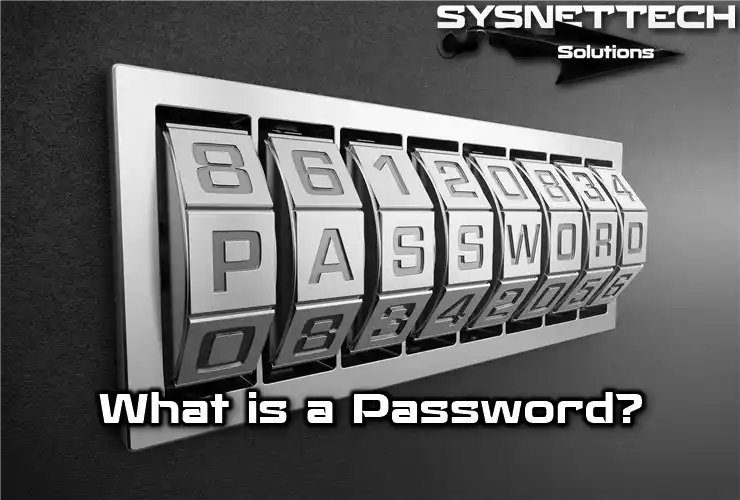A password authenticates access to secret PC resources. Furthermore, it uses personal info to control access.

What is a Password Used for Security in Computer Systems in the Digital World?
Users’ passwords belong only to them, so keep them secret. So, passcodes must remain private to those with access.
They get info with the relevant service’s password. Moreover, they must know the passcode for specific service access. They can only access the system if the word matches the requirements. So, incorrect data leads to denied entry permission.
Passwords used since ancient times: guards allowed access to those who knew the password. In the past, they asked for passwords to grant login.
The passwords control access to PCs, phones, TV boxes, and ATMs. Moreover, people commonly use them in today’s technological age.
Users use passcodes to log in to accounts, emails, databases, and web pages. They also use them to connect to servers or read electronic newspapers on sites.
What is Password Security?
Login credentials prevent outsiders from accessing specific resources for complete control. So, it’s essential to provide full access control. Password security enhances against unauthorized users effectively. As a result, it defends the service from login.
Specific password-protected systems, such as academic websites, pose minimal risk. Also, online services often have little or no chance. Here, login requires an email and password for the website. So, they use an email and passcode for access.
The risk ratio is when others intercept the user’s requested info. Thus, it affects accessing purchased services securely. While finding an email is easy, maximizing security requires vital keys. Moreover, strong password security enhances protection.
What are the Precautions to Take When Creating a Password?
Studying many factors ensures a safe password system. Further, equipping a secure key involves analyzing various aspects.
As a result, make safe computer systems; you can look into them quickly if necessary. People who make these systems should ensure they are secure and easy to investigate.
Ways to secure a system include preventing password guessing. Moreover, mixed methods ensure system protection, like key guessing. When attackers try to imagine a passcode, it can significantly harm system security. It is crucial to prevent guessing attempts to maintain system security.
Systems often restrict entry after repeated failed password security attempts. Further, some plans limit the entry count after many fault tries. To safeguard private company data, they must avoid simple passcodes. Also, prevent codes like birthdays, names, or common words.
Avoid hint text entries; they can compromise critical protection. Also, hints may reveal authentication codes, making them vulnerable.
Attackers use guess lists and high-speed software to crack passwords faster. This threatens safety by exploiting user hints.
How to Store Passwords?
Saving passwords as text files is risky because it makes it easier for someone to get them without permission. Keeping all the passcodes can pose a potential danger.
Using the same passcode for different accounts can severely compromise login credentials. If one account gets compromised, it may make others vulnerable as well.
The most secure systems encrypt passwords to prevent unauthorized access. This adds difficulty for internal attackers trying to gain entry.
When entering a secret code, the system generates a hash for entry. As a consequence, the approach allows access if the codes match.
Encrypted text generated with code and cryptographic function enhances protection. This prevents attackers from creating lists of standard keys. Common encryption functions used include MD5 and SHA1.
Well-designed password storage systems prevent direct text recovery. Also, calculation methods are unable to find the text.
If an attacker obtains the generated value list, they can use tools to compare encrypted results. Also, they may try different variations using extensive code lists.
Tools show strength against code attacks, reducing risk. Moreover, using a function for crucial derivation adds protection.
Eavesdropping Attacks in Hacking a Password
During transmission to the authentication system, codes might get intercepted. Code sent through an unsecured cable can leak data externally. But, using secure cabling prevents such data leaks.
Hackers can steal code sent online without detection. Also, attackers analyze info packets for login details.
Cable modems are prone to eavesdropping, unlike DSL or phones. Thus, attacks exploit cabling and network weaknesses easily.
The risk of Internet code hijacking is lower with built-in browser safety. Also, this layer effectively protects the information sent.
Active TLS shows a secure transmission with a closed lock icon. Furthermore, users recognize and trust this visual hint.
Forgotten Passcode Renewal Systems
If forgotten or compromised by users, the system updates the codes. Also, this ensures constant safety and user comfort.
Websites let users save keys in browsers for convenience. Also, this helps quickly secure entry later on. “Remember me” compromises security with saved login details. So, avoiding this option increases your account login credentials.
In short, avoid problems with identity management; automatically replace lost passwords. In addition, this technology efficiently simplifies secure access management.
Systems verify users by comparing answers to predefined questions. As a result, the system securely confirms user identity. Regular password changes risk old ones getting hacked easily. So, this encourages more guessing by potential attackers.
Also, this causes users to need to remember their current passcode. For this reason, they write their keys in visible places or tend to reuse their previous keys.
Characteristics of a Protected System
It increases software safety with these basic precautions for password security. Additionally, these steps help protect your critical systems.
- While accessing the system, it should prevent repeating the security codes on the display screen.
- Passwords should be long enough to ensure protection. This helps prevent illegal entry effectively, enhancing safety.
- For security, make sure keys contain special characters or numbers. As a result, this significantly increases the safety of your key.
- Let users re-enter passwords after a period of inactivity. So, this helps maintain account safety over time.
- Have a policy for secure critical keys’ protection. This ensures better safeguarding of essential info.
- Use a mix of letters, numbers, and unique characters randomly. This enhances passcode strength for improved protection.
- Add or configure a virtual keyboard as an alternative to the physical input method. As a result, this increases protection against potential keyloggers.
- Check for new passwords to avoid similarities with previous ones. It also increases basic security against potential breaches.
Avoiding the Possibility of Finding a Password
Studies involve quickly guessing about 60% of user-selected keys. As a result of this, it highlights the importance of stronger passwords.
Today, the list of preset keys users create is typical on the Internet. Thus, if a user chooses easy-to-discover personal data as a key, an attacker can easily find it.
Most of the personal data about individuals is now available on online platforms. Usually, a person pretending to be a social worker conducting surveys can get users’ keys.
Techniques for Creating Strong Passwords
Weak keys are predictable, often using short default words or variations of the username. As a result, they risk account vulnerability and breaches.
Primary keys must be extended, random, contain numbers, and be user-generated. It also increases safety against potentially dangerous access.
Practical keys are more accessible and rememberable with enough random characters. So, they offer better protection against unauthorized login attempts.
They might choose a password with phrases or compound words. In such cases, random letters might represent word initials. So, make passwords memorable: use random words or syllables. This approach balances security and ease of recall.
Memorable and Complex Words
Secure passwords include random characters and upper/lowercase letters, but remembering is challenging. Fortunately, they can use methods for managing complex words.
Users combine ways to remember passwords securely despite warnings. Moreover, they avoid writing or reusing keys for safety.
Software stores encrypted codes for many accounts conveniently and securely. Furthermore, this approach simplifies password management and enhances safety.
Other Safety Precautions
- One-Time Passwords
Using one-time keys boosts security by preventing potential attacks. Also, this reduces exposure to prohibited access tries. One-time keys can be inconvenient but are crucial for safety. Moreover, online banking systems commonly use them.
- Access Control
Access control uses changing symbols for better protection. In contrast, these symbols shift every minute for added guarding. Users only sometimes remember large keys from secure login methods. Thus, they are stored on devices like computers and flash drives.
- Biometric Control
Biometric methods use face or fingerprint features, enhancing guarding. However, these methods might be costly to install.
Conclusion
If I were to summarize the importance of passwords, I would say that they are essential for our data security. We need to use strong passwords when communicating digitally or accessing resources. Therefore, we must create a solid and unique secret code for each website or service.
Additionally, we should store our security codes in safe places. By doing this, we can prevent possible attacks or theft. In fact, this is a must for password security.
In short, in today’s technology revolution, we should not share our access information with other people. Whether you are a parent or a system administrator, remember that password management is serious business.



